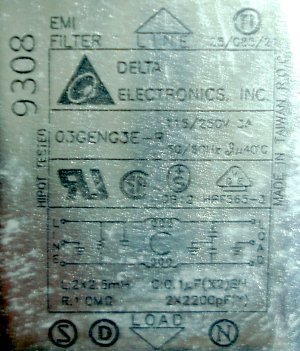- Joined
- Dec 29, 2012
- Messages
- 394
When I bought my new (to me) SLOTTA lathe the first thing I have put on it was a Varible Frequency Drive (VFD) to have variable speed.
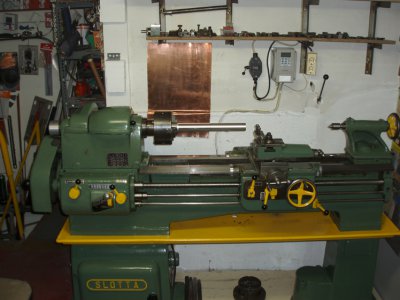
It is a cheap Chinese VFD that proved to do the job without any problems.
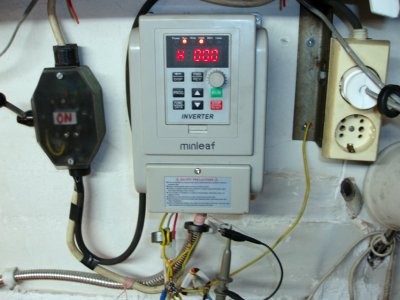
When I am in the shop I do some machining or electronics work or I browse the internet looking for something. I never do two of them at the same time. So I never noticed that whenever my lathe works the internet connection is down. Of course whenever you miss something your other half notices it and informs you instantly. To cut the story short, whenever the inverter was working there was no internet in the house! I had to either work on my minilathe or use the VFD when no one was around!
I decided to tackle the problem asap as I needed my lathe and the rest of the gang needed the internet connection.
Doing some research on the matter I found out that this is a very common problem that EVERY vfd causes!
Electromagnetic interference (EMI), also called electrical noise, is the unwanted signals generated by electrical & electronic equipment. EMI VFD problems range from corrupted data transmission to electric motor drive damage. Modern VFDs using IGBT switches for motor frequency control are very efficient because of their high switching speed. Unfortunately the high-speed switching also results in much higher EMI being generated. All VFD manufacturers detail installation procedures that must be followed in order to prevent excessive noise on both sides of the VFD.
From recognizing a problem to find a solution usually, there is some distance!
The first thing I thought was that there was no need to “reinvent the wheel” as there are plenty of filters to nearly every electrical appliance. So the first filter donor was an old computer PSU.
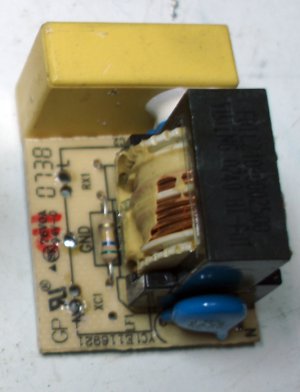
The filter was connected between power line and the VFD but proved to be inadequate for the job. The internet went down when the VFD started.
I thought that the filter was small and I used a larger one (size matters here as well?)
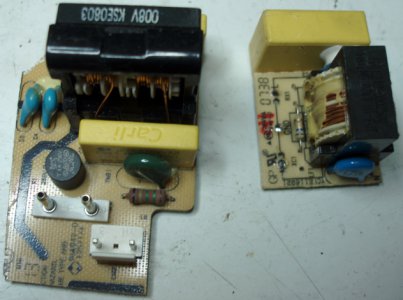
Results were disappointing again!
I even used a filter from a microwave oven that looked promising
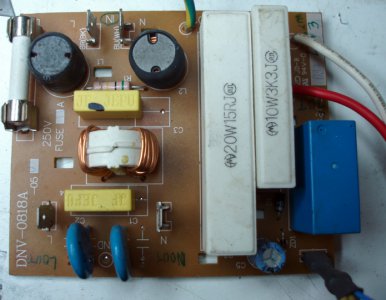
I also screened the output cable by putting it through a metallic shield that was grounded at both ends.
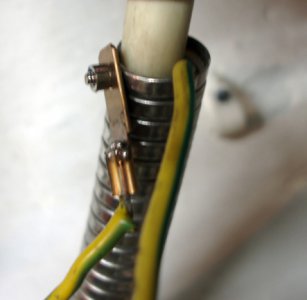
No results either! VFD ON internet OFF!!!
I decided to approach the problem in a more systematic way!
First of all I needed to “see” what happened to the power line when the VFD was ON.
I used my oscilloscope that I connected to the power cable and the VFD output by winding a 9 turns of wire around each cable to make a “current transformer”. As I cannot measure the current directly, I measure the voltage so I have the coil connected to a 1k resistor (burden resistor) and measure the voltage across it. The scope takes the voltage measurement across the resistor that caused by the current induced to the 9 turns of wire I have wrapped around the power cable.
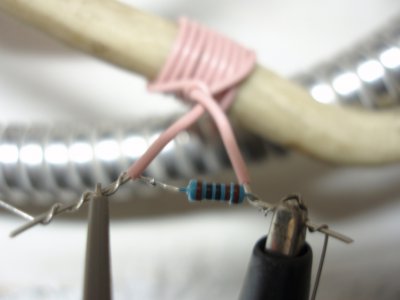
I made exactly the same configuration to the cable that goes from the VFD to motor so that the 2 channel scope could read both of them at the same time
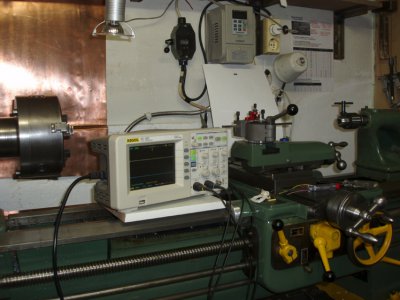
In case you are wondering, the 50 HZ signals from the grid that goes to the VFD by the live wire are going back to the grid by the neuter wire cancelling each other so they do not leave a trace on the scope.
The screen of the scope when the VFD was ON showed what happened
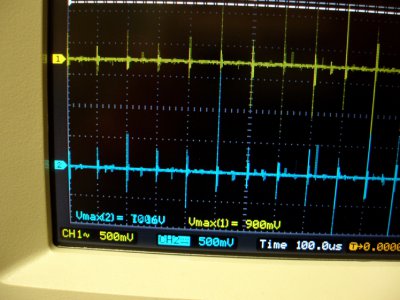
You can see all kinds of noise picked up by the coil. There is noise (more than 1 Volt) on both ends of the VFD, to the 230V input (yellow) and to the motor output (blue).
Next, to eliminate the noise, I tried a filter from a broken Uninterrupted Power Supply (UPS) system that works on a similar way (like the VFDs) using transistors to switch ON and OFF in very high speeds.
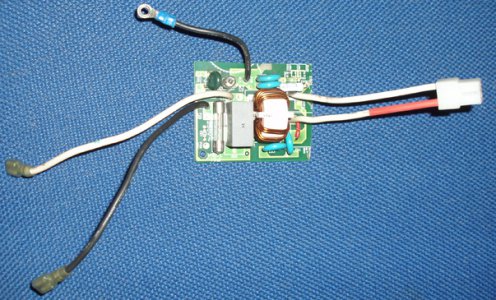
I connected it to the input of the VFD and tested it with the scope.
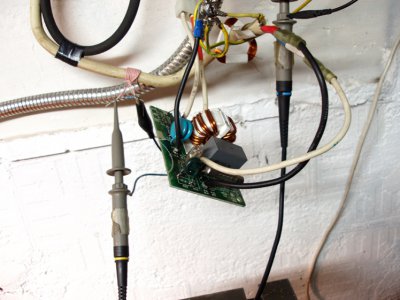
The results were also disappointing
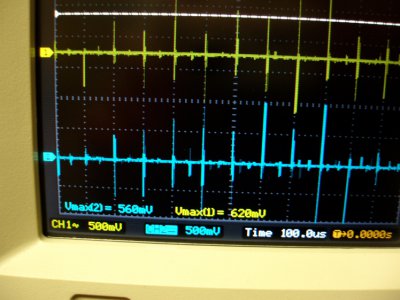
The noise levels although were 50% lower (around 0.6 Volts) the internet kept switching OFF when VFD was ON.
MORE RESEARCH FOR A SOLUTION
In industry, they sell ferrite toroidal coils for that purpose, they give some simple instructions on how to wind some wires around it to make a filter and they claim that the interference will go.
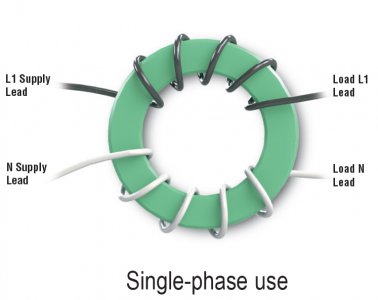
The principle of operation of these in very simple terms is as follows:
For 4 turns of wire at frequencies up to 100 kHz the inductance is around 200uH then as the frequency increases the inductance drops to very low values (practically 0)
At very low frequency (0 to 400 Hz is the produced frequency of the VFD for the motor) there is very little impedance (resistance) so signals flow right through the coil (as if it was a straight piece of wire). As the frequency goes higher so does the impedance! That is as the frequency goes higher the coil blocks more and more of these higher frequencies.
A very common size of these coils is 2.5x1.5x1" that you can get easily at your side of the pond but on this side the only place I found something similar was through eBay in next door Bulgaria, it will be in my doorstep in 25 to 40 days though!!
Until then I had to use whatever I had in the electronic parts bin. I found some smaller toroids and run the wires through them or wind some wires around them.
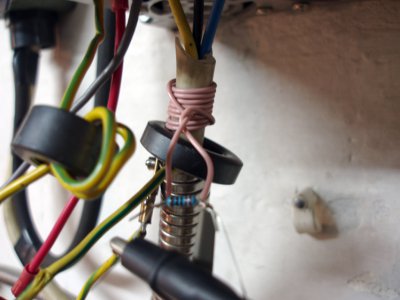
As I expected the effects of them were negligible.
More research on how to use small ferrites for a big result enlightened me a little:
“Wrapping a wire once around multiple cores is equivalent to wrapping a wire multiple times around one core. If possible try to attain at least one wrap from each phase around the stack of cores.”
Aha! there is some hope! A different approach now!
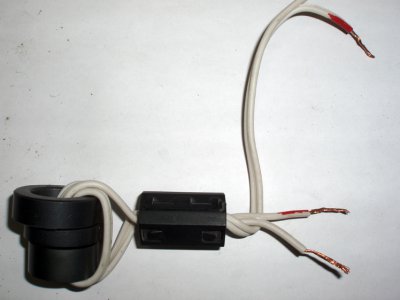
A few turns around 3 different toroids and a twist between the wires with an extra ferrite around the twist gave me a new filter for testing.
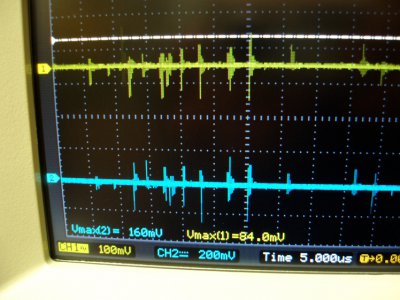
At last some good results!
This simple filter managed to reduce the noise by 90%
Amazingly the output noise was reduced by 60% also.
The most important result was that the internet was not affected any more by the VFD! We are in the right track.
I could have stopped here and consider the problem solved but...
We always try to make things better! No?
Next step was to "upgrade" the filter by adding a small filtered connector to it as well.
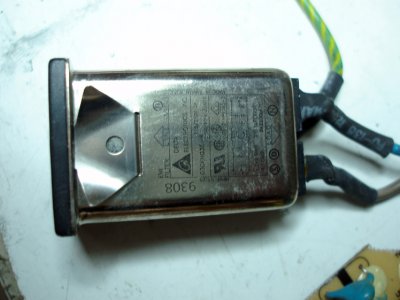
Naturally putting it in a metallic box and having connections at both ends completed it.
An old power supply box from an Apple Macintosh provided the boxing essentials.
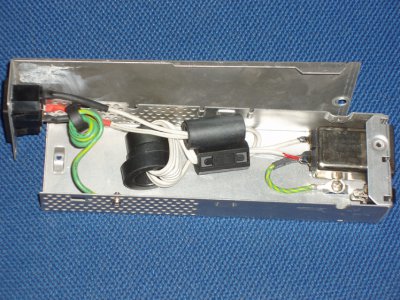
Proper grounding of the box and isolation of the coils from the metal surrounding finished the filter.
Then testing it "in situ"
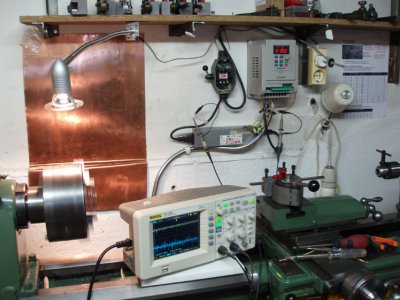
The results now were just AMAZING!
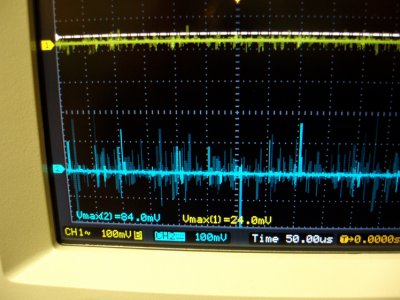
The noise at the input (power cable side) was reduced by 97% (from 900mV to 24mV).
In the output (motor cable side) the noise went down more than 90% (from 1006mV to 84mV).
I will test the output side with the eBay ferrite toroids (when they arrive) to see if I can reduce the output noise further.
Thanks for reading
Petros

It is a cheap Chinese VFD that proved to do the job without any problems.

When I am in the shop I do some machining or electronics work or I browse the internet looking for something. I never do two of them at the same time. So I never noticed that whenever my lathe works the internet connection is down. Of course whenever you miss something your other half notices it and informs you instantly. To cut the story short, whenever the inverter was working there was no internet in the house! I had to either work on my minilathe or use the VFD when no one was around!
I decided to tackle the problem asap as I needed my lathe and the rest of the gang needed the internet connection.
Doing some research on the matter I found out that this is a very common problem that EVERY vfd causes!
Electromagnetic interference (EMI), also called electrical noise, is the unwanted signals generated by electrical & electronic equipment. EMI VFD problems range from corrupted data transmission to electric motor drive damage. Modern VFDs using IGBT switches for motor frequency control are very efficient because of their high switching speed. Unfortunately the high-speed switching also results in much higher EMI being generated. All VFD manufacturers detail installation procedures that must be followed in order to prevent excessive noise on both sides of the VFD.
From recognizing a problem to find a solution usually, there is some distance!
The first thing I thought was that there was no need to “reinvent the wheel” as there are plenty of filters to nearly every electrical appliance. So the first filter donor was an old computer PSU.

The filter was connected between power line and the VFD but proved to be inadequate for the job. The internet went down when the VFD started.
I thought that the filter was small and I used a larger one (size matters here as well?)

Results were disappointing again!
I even used a filter from a microwave oven that looked promising

I also screened the output cable by putting it through a metallic shield that was grounded at both ends.

No results either! VFD ON internet OFF!!!
I decided to approach the problem in a more systematic way!
First of all I needed to “see” what happened to the power line when the VFD was ON.
I used my oscilloscope that I connected to the power cable and the VFD output by winding a 9 turns of wire around each cable to make a “current transformer”. As I cannot measure the current directly, I measure the voltage so I have the coil connected to a 1k resistor (burden resistor) and measure the voltage across it. The scope takes the voltage measurement across the resistor that caused by the current induced to the 9 turns of wire I have wrapped around the power cable.

I made exactly the same configuration to the cable that goes from the VFD to motor so that the 2 channel scope could read both of them at the same time

In case you are wondering, the 50 HZ signals from the grid that goes to the VFD by the live wire are going back to the grid by the neuter wire cancelling each other so they do not leave a trace on the scope.
The screen of the scope when the VFD was ON showed what happened

You can see all kinds of noise picked up by the coil. There is noise (more than 1 Volt) on both ends of the VFD, to the 230V input (yellow) and to the motor output (blue).
Next, to eliminate the noise, I tried a filter from a broken Uninterrupted Power Supply (UPS) system that works on a similar way (like the VFDs) using transistors to switch ON and OFF in very high speeds.

I connected it to the input of the VFD and tested it with the scope.

The results were also disappointing

The noise levels although were 50% lower (around 0.6 Volts) the internet kept switching OFF when VFD was ON.
MORE RESEARCH FOR A SOLUTION
In industry, they sell ferrite toroidal coils for that purpose, they give some simple instructions on how to wind some wires around it to make a filter and they claim that the interference will go.

The principle of operation of these in very simple terms is as follows:
For 4 turns of wire at frequencies up to 100 kHz the inductance is around 200uH then as the frequency increases the inductance drops to very low values (practically 0)
At very low frequency (0 to 400 Hz is the produced frequency of the VFD for the motor) there is very little impedance (resistance) so signals flow right through the coil (as if it was a straight piece of wire). As the frequency goes higher so does the impedance! That is as the frequency goes higher the coil blocks more and more of these higher frequencies.
A very common size of these coils is 2.5x1.5x1" that you can get easily at your side of the pond but on this side the only place I found something similar was through eBay in next door Bulgaria, it will be in my doorstep in 25 to 40 days though!!
Until then I had to use whatever I had in the electronic parts bin. I found some smaller toroids and run the wires through them or wind some wires around them.

As I expected the effects of them were negligible.
More research on how to use small ferrites for a big result enlightened me a little:
“Wrapping a wire once around multiple cores is equivalent to wrapping a wire multiple times around one core. If possible try to attain at least one wrap from each phase around the stack of cores.”
Aha! there is some hope! A different approach now!

A few turns around 3 different toroids and a twist between the wires with an extra ferrite around the twist gave me a new filter for testing.

At last some good results!
This simple filter managed to reduce the noise by 90%
Amazingly the output noise was reduced by 60% also.
The most important result was that the internet was not affected any more by the VFD! We are in the right track.
I could have stopped here and consider the problem solved but...
We always try to make things better! No?
Next step was to "upgrade" the filter by adding a small filtered connector to it as well.

Naturally putting it in a metallic box and having connections at both ends completed it.
An old power supply box from an Apple Macintosh provided the boxing essentials.

Proper grounding of the box and isolation of the coils from the metal surrounding finished the filter.
Then testing it "in situ"

The results now were just AMAZING!

The noise at the input (power cable side) was reduced by 97% (from 900mV to 24mV).
In the output (motor cable side) the noise went down more than 90% (from 1006mV to 84mV).
I will test the output side with the eBay ferrite toroids (when they arrive) to see if I can reduce the output noise further.
Thanks for reading
Petros


